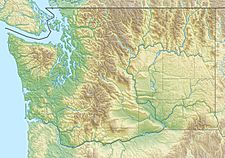Spider Glacier (Spider Mountain, Washington) facts for kids
Quick facts for kids Spider Glacier |
|
|---|---|
| Type | Mountain glacier |
| Location | Chelan County, Washington, U.S. |
| Coordinates | 48°24′49″N 121°01′54″W / 48.41361°N 121.03167°W |
| Length | .30 mi (0.48 km) |
| Terminus | Barren rock/icefall |
| Status | Retreating |
Spider Glacier is a cool natural ice formation found in the Wenatchee National Forest in the state of Washington, U.S. It sits on the north side of a peak called Spider Mountain. This glacier is like a slow-moving river of ice, and it's an important part of the natural landscape in this area.
Contents
Discovering Spider Glacier
Spider Glacier stretches out for about .30 mi (0.48 km) (which is about half a kilometer). It spreads across the northern face of Spider Mountain for about .90 mi (1.45 km) (nearly 1.5 kilometers). Imagine a huge sheet of ice clinging to the side of a mountain!
Where is it Located?
This amazing glacier is nestled in the North Cascades mountain range. It's in Chelan County, Washington. The area around it is wild and beautiful, full of tall peaks and deep valleys.
What Makes it Special?
Spider Glacier is separated from another glacier, called Middle Cascade Glacier, by a sharp, rocky ridge. This ridge is known as an arête. An arête is formed when two glaciers erode (wear away) rock on opposite sides, leaving a narrow, jagged wall between them.
It's important not to mix up this Spider Glacier with another one nearby that has the same name! The other one is called Spider Glacier (Phelps Ridge, Washington).
Glaciers: Earth's Ice Giants
Glaciers are huge bodies of ice that form over many years. They are made from layers of snow that get compressed and turn into ice. These ice giants move very slowly, shaping the land as they go. They can carve out valleys, create lakes, and even form sharp mountain ridges like arêtes.
Spider Glacier, like many glaciers around the world, is currently "retreating." This means it's getting smaller over time. Scientists study glaciers like Spider Glacier to understand how Earth's climate is changing.


